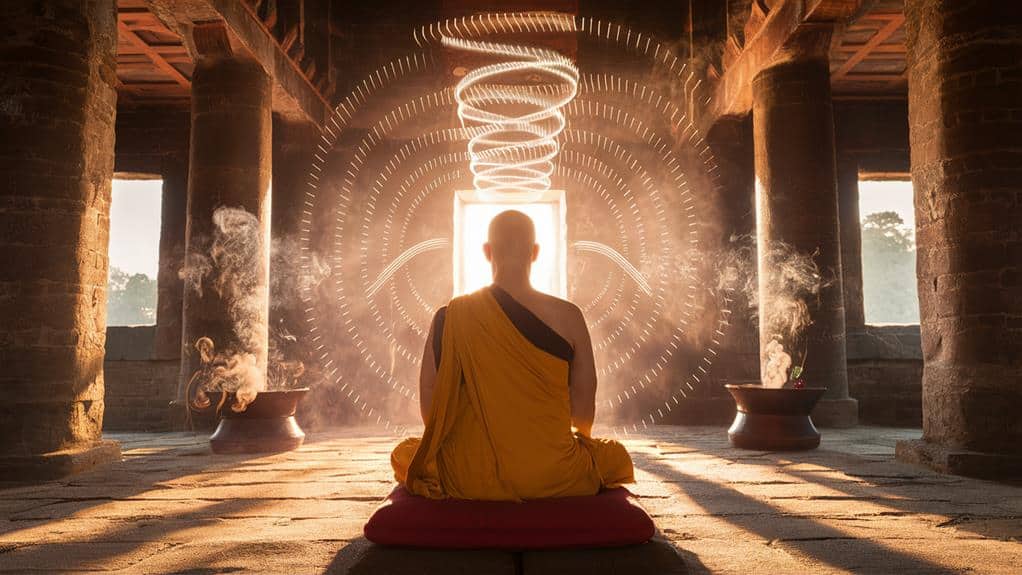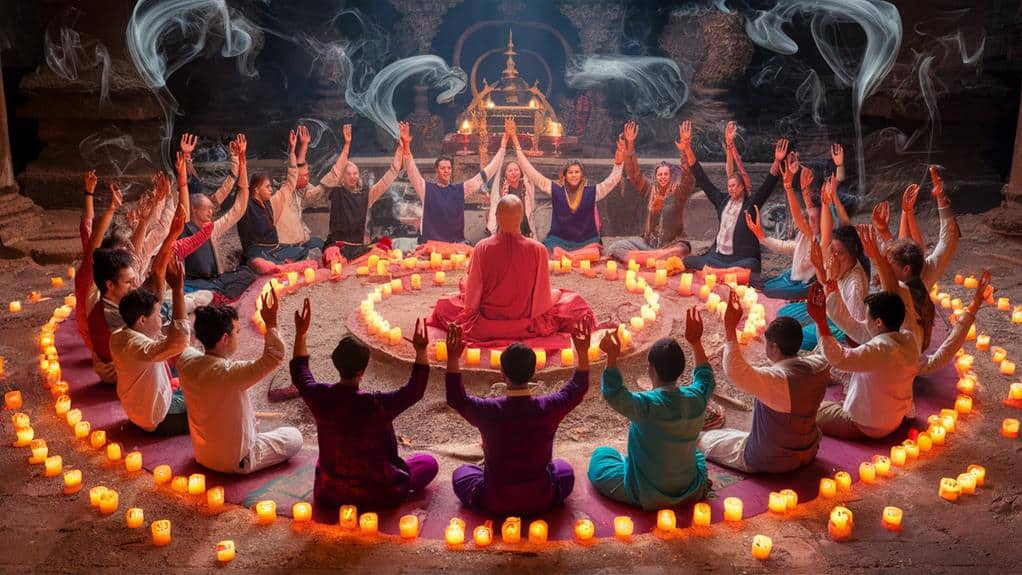The Use of Mantras and Chanting in Mystical Practices
You’ve likely encountered the distant echoes of chanting or perhaps heard the rhythmic repetition of “Om” in a yoga class, but these practices represent just the surface of humanity’s profound relationship with sacred sound. Throughout history, mystics and spiritual seekers have understood that specific vocal patterns can reveal altered states of consciousness and facilitate deeper connections with the divine. While you might dismiss such claims as ancient superstition, modern science has begun to validate what practitioners have known for millennia: mantras and chanting can measurably affect your brain chemistry, emotional state, and even physical wellbeing.
Origins of Sacred Sound

Sound healing traditions trace their roots to humanity’s earliest civilizations, where ancient cultures discovered the profound effects of vocal vibrations on consciousness and wellbeing.
You’ll find evidence of sacred sound practices in the archaeological records of civilizations spanning from Egypt to India, where priests and mystics developed sophisticated systems of tonal healing and spiritual awakening.
As you explore these ancient origins, you’ll discover that your ancestors understood something profound: the human voice carries transformative power that transcends ordinary communication.
They recognized that specific sounds, when properly intoned, could alter states of consciousness and connect you to deeper dimensions of experience.
You’ll see this wisdom reflected in the Sanskrit syllable “Om,” considered the primordial sound of creation, and in the Gregorian chants that still echo through monastery halls.
These early sound healers didn’t just stumble upon these practices – they methodically developed them through generations of careful observation and experimentation.
They’ve left you a legacy of sonic tools that can help you access expanded states of awareness and tap into the vibrational fabric of existence itself.
Understanding Mantra Mechanics
When you examine the mechanics of mantras, you’ll find they operate through precise combinations of rhythm, frequency, and intention. Like ripples in a cosmic pond, each syllable you voice creates specific vibrational patterns that resonate with both your physical body and subtle energy systems.
You’re not just making sounds; you’re engaging in an ancient technology that transforms consciousness through carefully calibrated acoustic formulas.
As you explore deeper into mantra practice, you’ll discover how each sacred sound sequence activates particular energy centers within your being. The Sanskrit syllables, when properly intoned, create measurable changes in your brainwave patterns and physiological responses.
You’ll notice how certain mantras ground you through their deep, bass frequencies, while others elevate your awareness through higher pitched vibrations.
Your breath, voice, and focused attention work together as you chant, forming a bridge between your ordinary awareness and expanded states of consciousness.
Through consistent practice, you’ll experience how mantras serve as keys that release dormant potentials within your psyche, revealing layers of reality that transcend ordinary perception.
Global Chanting Traditions

The world’s sacred chanting traditions span every inhabited continent, revealing humanity’s universal recognition of sound as a spiritual gateway. You’ll find Gregorian chants echoing through European monasteries, while Tibetan monks intone deep, resonant overtones that seem to pierce the veil between dimensions.
In Africa’s heart, rhythmic call-and-response chanting weaves communities together in sacred celebration.
When you explore these diverse traditions, you’ll discover how Native American prayer songs connect practitioners to ancestral wisdom, while Hindu kirtan invites you to merge with divine consciousness through repetitive, melodic verses.
The Aboriginal dreamtime ceremonies of Australia use chanting to map both physical and spiritual landscapes, maintaining ancient connections to land and spirit.
You’re part of this timeless legacy when you engage with any of these practices. Whether it’s the Sufi zikr’s hypnotic rhythms or Japanese Shomyo’s ethereal tones, you’re tapping into humanity’s shared understanding that sacred sound transforms consciousness.
These traditions aren’t merely cultural artifacts – they’re living bridges between your everyday awareness and deeper dimensions of spiritual experience, offering you direct access to states of expanded consciousness that transcend cultural boundaries.
Scientific Research Behind Mantras
Modern neuroscience has begun validating what ancient practitioners understood intuitively about mantras. Through advanced brain imaging techniques, you’ll discover that repetitive chanting creates measurable changes in neural activity, particularly in regions associated with attention, emotional regulation, and self-awareness.
When you engage in mantra meditation, your brain waves shift into more coherent patterns, often displaying increased alpha and theta waves linked to deep relaxation and heightened consciousness.
You’ll find that research has revealed how mantras affect your autonomic nervous system, lowering blood pressure and reducing stress hormones like cortisol. Scientists have documented that the vibrations produced during chanting stimulate your vagus nerve, activating your body’s natural relaxation response.
The rhythmic nature of mantras synchronizes your breathing patterns, leading to improved heart rate variability and enhanced immune function.
Studies at major universities have shown that long-term practitioners of mantra meditation demonstrate increased gray matter density in areas of the brain associated with compassion, memory, and executive decision-making.
You’re not just engaging in an ancient spiritual practice – you’re participating in a scientifically validated method of neuroplastic transformation.
Modern Applications in Wellness

Throughout the past decade, wellness practitioners have increasingly incorporated mantras and chanting into mainstream therapeutic programs. You’ll find these ancient practices now being used in modern settings like yoga studios, meditation centers, and even corporate wellness programs, where they’re helping people manage stress and enhance mindfulness.
As you explore these contemporary applications, you’ll discover that what was once considered purely spiritual has evolved into a practical tool for mental health and emotional balance.
You can experience the transformative power of mantras in various modern contexts, from mindfulness apps that guide you through daily chanting sessions to stress management workshops that integrate traditional sounds with contemporary breathing techniques.
In your journey toward wellness, you’ll notice how these practices have been adapted to fit today’s fast-paced lifestyle while maintaining their essential meditative qualities.
Whether you’re seeking relief from anxiety, improved focus, or deeper self-awareness, mantras offer you a bridge between ancient wisdom and modern therapeutic needs.
Through regular practice, you’re able to access states of consciousness that foster both emotional resilience and mental clarity, making these time-tested techniques particularly relevant in our challenging contemporary world.
Starting Your Mantra Practice
Beginning a mantra practice doesn’t require complex preparations or special equipment – you’ll need only your voice, an open mind, and a quiet space. You’ll find that selecting your first mantra is deeply personal, whether you’re drawn to traditional Sanskrit syllables like “Om” or prefer simple affirmations in your native tongue.
Start by setting aside just 5-10 minutes daily, preferably at dawn when the world is still and your mind hasn’t yet cluttered with daily concerns. Sit comfortably with your spine straight, either cross-legged on the floor or in a chair with your feet planted firmly on the ground.
As you begin to chant, you’ll notice how the vibrations of your voice create subtle resonances throughout your body.
Don’t worry about achieving perfection – let your practice evolve naturally. You’ll discover that the power of mantras lies not in flawless pronunciation but in your intention and dedication.
As you deepen your practice, you may extend your sessions, experiment with different mantras, or incorporate gentle swaying movements. Trust that each session brings you closer to a profound understanding of your inner landscape and universal consciousness.









